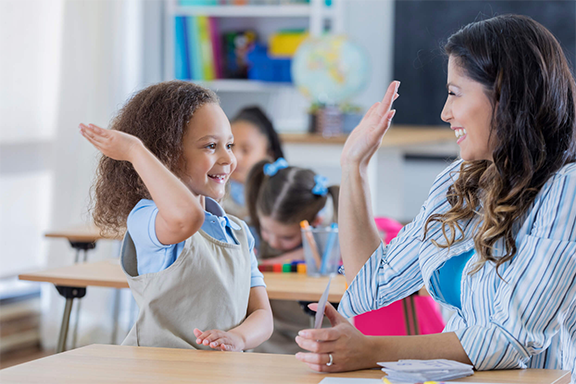
By teacher guest blogger Kathryn Rose
Once again, the holiday season is upon us and many teachers feel like they are hurtling down a crazy few weeks filled with curriculum catch-up, classroom parties, and students watching the clock waiting for winter break. Although let’s be honest, aren’t we all just a little bit excited for a break?
Everything about teaching seems to accelerate in December. Projects need to be completed, classrooms need to be cleaned, and grades need to be turned in. But as the semester assessments start to roll in, many teachers also start to wonder about the new year. What strategies have been working and should continue? What needs to change so that students can find more academic and social-emotional success?
While graphic organizers and extra study time might benefit a few students, there is one very easy classroom management strategy that will benefit everyone. It also happens to fall in line with December’s seasonal aspirations! It’s time to talk about your PRR -- your praise-to-reprimand ratio.
The Research on Praise
Clearly, praise may not be a silver bullet that solves all of your students’ academic needs. Classrooms are complicated and nuanced places. But tracking your PRR is definitely not a strategy to overlook.
According to a new study published in Sage Journals, middle schoolers that receive higher amounts of praise in relation to being reprimanded show positive improvements in on-task and prosocial behavior that is then reflected in their school work. This study builds upon previous work surrounding “praise ratios'' by Vanderbilt University. In the earlier study, researchers go on to assert that teachers should try to keep their PRR to a 4:1 ratio, meaning that there should be four praise statements for every one reprimand.
The research on PRR continues to be solid and easy to replicate. In classrooms where the teacher was committed to the 4:1 ratio, on-task behavior increased by 60-70% and disruptions were roughly cut in half. The positive impact of this ratio is felt most deeply by students who also carry emotional or behavioral disorders. For these students, a 1:1 PRR can mean the difference of an entire letter grade in subjects they find difficult or challenging.
What Works (and What Doesn’t!)
While there are certain behaviors that must include social or behavior consequences, negative attention from a teacher, especially when done publicly, does not show the same consistent results in regards to driving down undesirable behaviors. In fact, depending on the age of the student, educators might even see an increase in disruptions if the student feels embarrassed or singled out.
Middle school teachers should be especially cognizant of this resistance. As students reach puberty and start their adolescent journey, they are more likely to question authority figures and the rules they are told to abide by. Teens are also deeply entrenched in the social context of their learning. They feel that their social status within their school system is directly linked to how they are viewed in the classroom.
Behavior-specific praise that is given out in the right ratio changes the direction of that narrative. It gives students the ability to see how often they meet classroom expectations and it gives them a sense of belonging.
How to Implement a Praiseworthy PRR Ratio
Creating a mindful approach to praise is important. Even young students can tell when praise is insincere. The educator must keep in mind that praise should be used honestly and effectively. Here are a few tips to get you started:
• If you are trying to create a PRR baseline, keep track of how often you praise your students. Keeping track can also give you insight into students or situations that you might be overlooking.
• Establish your behavioral expectations for the class publicly. Repeat them often. Students cannot meet your demands if they do not know what they are or do not understand them. Take time to clarify expectations if it seems like students are struggling to meet them.
• Deliver your behavior-specific praise as close to the desired behavior as possible. Use a sincere tone of voice and keep away from praise that is ability-centered. Behavior-specific praise centers around specific actions that all students should be able to achieve.
• Praise can be delivered both publicly and privately, depending on the child or situation. However, corrections should be given privately. Public shaming distorts a child’s self-image and can lead to more serious behavioral problems later down the road.
Historically, this time of the year can be really hard on teachers. While everyone else seems to be filling up their cups with extra cheer, an educator’s “to do” list is never-ending can often lead to overcorrection and under praising students because everyone just needs to get through the day with their spelling homework and math test in their backpack. But, if you want your students to be excited to see you after winter break, being mindful of your PRR can help you make a smooth transition into 2022.
As always, we like to practice what we preach! From everyone at MAXCases -- thank you for your service. Thank you for trusting us with you
------------------------------------------
About Kathryn Rose
Kathryn Rose is currently a virtual tutor and a museum resource teacher. She also freelances for businesses and startups in the education field. She has taught at her city’s botanic garden for 12 years and has been a Social Studies teacher in both private and public schools.


